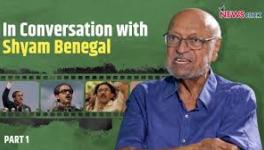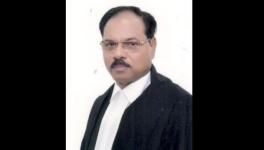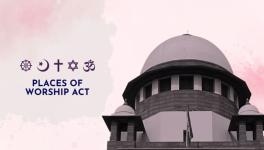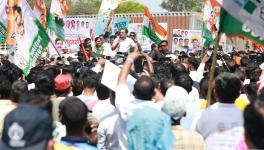Babri Masjid Anniversary: ‘You Won’t Find Rama in Modi, Yogi’
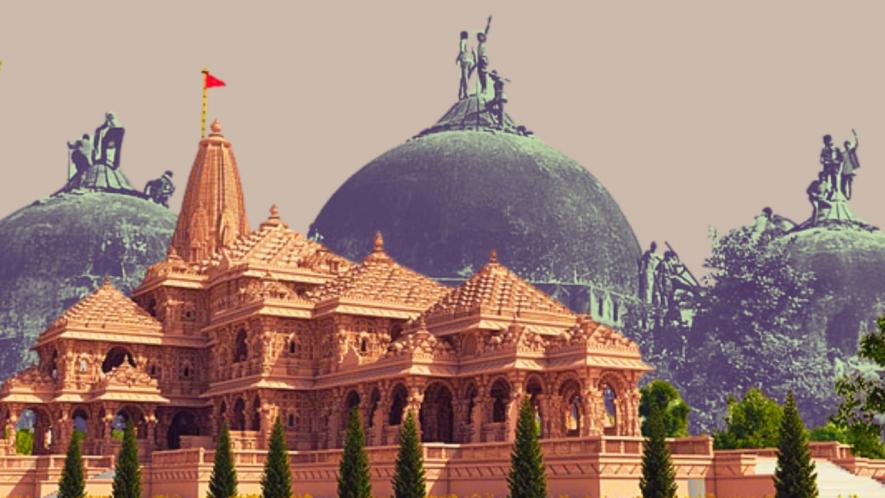
The Vishwanath temple, a revered abode of Lord Shiva in Kashi, has been a source of much controversy in recent times. In this interview, Rajendra Prasad Tiwari, former mahant of the iconic temple, describes how faith, and our ideas about it, are being changed through politics—and how it was also done, decades ago, in the case of the Babri mosque that once stood in Ayodhya. He says he considers December 6 a ‘Black Day’ for the country, whose message of bad tidings are still turning to reality. Edited excerpts from an interview conducted in Hindi.
Pragya Singh: What was your first response when the Babri Masjid in Ayodhya was demolished on 6 December 6, 1992?
Rajendra Prasad Tiwari: Recall the environment created across the country in those days. The kar sevaks had gone to Ayodhya thinking that they would propagate the outcome of their actions throughout the country. However, they [the leaders of the Rashtriya Swayamsevak Sangh, Vishwa Hindu Parishad and Bharatiya Janata Party] lost control over these kar sevaks.
Recall also the maun [silence] of the Congress party’s Narasimha Rao government. Rao saw the Ram temple movement whipping up sentiments through yatra after yatra. He believed December 1992 would be a do-or-die moment that could take away a political weapon from them [Hindutva outfits].
And, post-demolition, no BJP leader took responsibility for it; all said that they lost control over kar sevaks. They shifted the blame to the Rao government, saying it should have stopped [the demolition].
In this environment, we could not immediately comprehend the significance of the demolition. Later, on closer examination, we understood it all as a pre-planned conspiracy.
Compare it with Anna Hazare’s anti-corruption movement, which demanded a Lok Pal, and which RSS workers supported. Today, all the supporters of that movement are in power, from Arvind Kejriwal to Kiran Bedi to VK Singh to Baba Ramdev, but the issues it raised are in cold storage despite raging corruption! So, the edifice of the RSS is based on lies and emotional blackmail, in which faith is used a crutch. Even their faith has no practical application in society.
PS: But one thing they do is search for proof in matters related to faith. Do you think belief requires proof?
RPT: Aastha dil se hoti hai, dastkhat se nahi hoti—Faith comes from the heart, not a rubber-stamp. What is it that they seek proof of?
PS: That Ram-Lalla was born at a particular spot, that a mosque was built over a temple…
RPT: In that case, did nobody repose faith in all the temples that were broken or displaced at Vishwanath-ji [during the construction of the Kashi Vishwanath Corridor]? Or is it that you can change the location of a temple, but others cannot?
Let’s see it another way. It has been 7 lakh years since Lord Rama departed from this earth, but nobody can show me any building on earth that old. It is our faith that tells us that some structure existed at any site in time immemorial.
Now, Aadi Shankaracharya re-established Sanatan Dharma after its struggles with Buddhism, and set up the four peeth to propagate it and assess all its faith-related matters. But the VHP (Vishwa Hindu Parishad) or RSS never communicate with the Shankaracharyas. And what role do they have in constructing a temple? The four Shankaracharyas, the Mahamandaleshwar and the members of the Ramanandi Sampradaya, should be involved in such a task. But not one of these people has been involved in the entire process [of re-thinking the Kashi Vishwanath or Ayodhya temple complexes].
Who was involved instead? People like Champat Rai, who [allegedly] sold land of the Ram Janmabhoomi trust, worth Rs.2 crore, for over Rs.18 crore.
We don’t even know what other wrongdoings were done in Ayodhya; only this one has come to light. But in Kashi, we watched them taking over homes and temples, using threat, coercion and force to build the Kashi Corridor. After all, everything is in their favour, from the courts to the judges, while people are not getting a chance to have their voices heard.
PS: Is it not injustice, in a way, that the temple in Ayodhya is coming up, but the court-ordered mosque is not?
RPT: Why do you expect justice from the government?
PS: Well, one does expect justice from the government, doesn't one?
RPT: From this government, you should not. When they call convicted rapists [and killers of Bilkis Bano and her family] ‘sanskari’ [cultured] and release them from their sentences, you should understand their mindset. Why expect justice from them?
If the courts and official machinery that implements the Constitution of India worked honestly in our country, the crime rate would be zero! But if the person implementing the Constitution decides not want to do something, the file [seeking justice] will just move from one desk to another.
Tell me one instance in which justice was delivered in the last 10 years. Or consider the five or six most crucial decisions of the Supreme Court. Did any (of those) do justice?
PS: But if injustice prevails, will not faith, Dharma, or the culture it represents become unrecognisable?
RPT: The Dharma you are referring to has no sense of ghrina, or hate and disgust, towards any community. It says people may have separate ways of worshipping or following their faith but are not apart. Take chandrama, the moon: can anybody say the moon is Hindu or Muslim? Does not everybody worship the same moon? Do not a Harijan and a Brahmin use the water of the same rivers? When it comes to the pratyaksha Ishwar, the visible God, everybody is in sync with it. Can anybody say that the moon or a river are Hindu or Muslim?
PS: It would be hilarious and ridiculous if someone tried!
RPT: These are the forms of God we all see, even if we do not see the invisible God. In other words, all can worship whom they wish; that is our creation, our gods, created by human beings, and we have given them different names. Somebody refers to god as Allah, God, Guru, Ishwar, or by any other name. The goal is the same: we want to reach that ultimate truth.
But today, Dharma is being explained in ways that seek to establish an individual's authority. This [new] meaning of Dharma is being spread through an over-active propaganda machinery with the media as its mouthpiece, and it is spreading poison throughout society.
PS: How is it changing society or culture?
RPT: Society is not ‘changing’; it is being distorted. A society that lacks sanskara is being created.
PS: What is being lost in this process?
RPT: When sanskara is distorted, all its symptoms take on a distorted form. It means that the component of humanity devolves to zero, and self-interest becomes supreme. They [the BJP] can go to any extent for supremacy and self-interest. You must understand the narrative in which a Prime Minister projects himself as a god and the media runs with it. Such propaganda for an individual creates distortions in State, society and religion.
They talk about Hindu Rashtra, but Ravana was also a Hindu raja, as were Kansa and Duryodhana. But people were unhappy with their rule. It was only Ramaraj during which everybody was happy.
PS: But can we say this for today's time?
RPT: Do you feel it is true today? Only people of their kind are happy. I do not even consider them a party. In a party, there is a vichardhara, an ideology. But here, even that has become zero. When that happens, an outfit takes the form of a gang where there is no give-and-take of ideas. Atal Bihari Vajpayee (former PM and BJP leader) tried to establish his party through political views, but today, the gang’s orders have become supreme.
PS: Can you give an example of this?
RPT: This gang got together and claimed that a Shiva linga had appeared [in the wazukhana at Gyanvapi mosque]. I alone refuted this claim; nobody else spoke out. Many allegations were made against me: that I have ‘joined hands with the Muslims’, etc.. But I alone have the evidence regarding the provenance of [Kashi Vishwanath temple].
Even then, I had said that the Gyanvapi mosque was a temple in the past, but the ‘Shiva linga’ they are talking about is not a Shiva linga. If it is, then [first they must] get it fully examined—you cannot install God through a media trial. They [the press] keep saying, ‘Prakat ho Gaye, Prakat ho Gaye, Prakat ho Gaye...the Shiva linga has appeared, the Shiva linga has appeared, the Shiva linga has appeared!’
PS: But if the Vishwanath temple is a jyotirlinga site, where Lord Shiva appeared on his own, how can it have more than one Shiva linga?
RPT: Exactly. I repeatedly said that the Vishwanath temple, which was once the Gyanvapi temple, was also ours—meaning that the same family of mahants, my ancestors, managed it. In 1659, when it was evident that the Gyanvapi temple would be broken, my ancestors took just the Shiva linga with them and moved away.
PS: So the jyotirlinga was taken away from the older temple?
RPT: Yes, and the Shiva linga worshipped today is located where my family and I lived; it was our residence. For 40 years, nobody disclosed that the Shiva linga was in our home. However, prayers continued uninterrupted at home, though not by the public.
After Aurangzeb died in 1707, Kashi residents were finally told that the Shiva linga was safe, although the temple had been broken. Then, people who used to pray at Gyanvapi, came and saw the Shiva linga and recognised it as the same Shiva linga they had worshipped four decades earlier. People resumed Darshana at my home every morning and evening. My house became a temple!
When Ahilyabai [Holkar] had a dream about building a temple for Lord Shiva, she visited Kashi and told my ancestor, ‘Mahant-ji, I want your entire house to construct the Vishwanath temple here!’ My ancestors agreed, and finally, Ahilyabai performed a grand inauguration of the temple. Its structure was small, but it was very beautiful.
However, the Shiva linga did not move to the spot identified by Ahilyabai. It remained established where it was, the proper rites were organised, and all four Shankaracharyas gave it due recognition. They acknowledged that the jyotirlinga was safe; it is the same Shiva linga, and that people have been worshipping it.
PS: So what is the other Shiva linga allegedly found in the Gyanvapi mosque?
RPT: Those people [Hindutva followers and leaders] are creating this new Shiva linga, not me! They have made it ‘appear' and are claiming whatever they wish about it. Why don’t they have it examined if it is a Shiva linga?
PS: Well, isn't that what they say, that they are getting it tested?
RPT: They are doing nothing! Why are they not getting the exact space where they say the Shiva linga appeared examined? Instead, they talk about the Nandi [statue], saying it sits facing [their new Shiva linga]. What they don’t say is that the Nandi statue was brought by the ruler of Nepal hundreds of years after the Vishwanath temple was built. My ancestors said it could not be installed as it was much bigger than the Shiva linga. But it was too big to carry back to Nepal, so it was placed on a small platform there. Now, they [the authorities constructing Kashi Corridor] broke and removed the inscription describing this provenance. They knew it would create hassles for them if they started building a new structure.
So, they remove any evidence that goes against them. But what can we do about it when the whole system is with them?
PS: But the Places of Worship Act says you cannot go around looking for temples under mosques or mosques under temples and so on.
RPT: This Act says all temples will be maintained in the state in which they were in 1947, but to what extent do they follow that Act? After all, the Shiva linga is still installed in Kashi Vishwanath, and the record says Maharani Ahilyabai constructed it with the permission of the mahant family, and she has not declared that she had the Shiva linga installed [meaning that the original Shiva linga remains consecrated as before]. So how much more proof [do they want]? I even have evidence that the temple was ours from the patta [deed] granted by Dara Shikoh, which is still with me.
PS: If temples were moved or broken to build the Kashi Vishwanath Corridor, and the existing Shiva linga were removed, does it mean the regime and its representatives lack faith? Or do they believe in something else?
RPT: They have faith only in power, not in religion or religious people. Sri Sri Ravi Shankar, Morari Bapu, Asaram Bapu, these are their sadhu-sants, from which you can estimate [what they repose faith in].
Why don’t they go to any Shankaracharya? Because the Shankaracharya do not accept them. They will go to Sri Sri Ravi Shankar, who backs them. I spoke with Ravi Shankar-ji, who said I should get involved in Modi-ji's prachar. So, this is their idea…
PS: How different is the Kashi Vishwanath temple area now from before?
RPT: As I have said before, it is not Vishwanath temple now. It has become ‘Vishwanath Mall’. You get everything you want there if you have money at your disposal—hotels, restaurants, the works.
PS: Alright, but you know that a Mughal demolished the Vishwanath temple. Does it not anger or upset you?
RPT: In those days, India had Rajtantra, King’s rule. Today, it has Loktantra, people’s rule. We can learn from what happened in those days, but we can’t say that we will do what happened then now.
PS: Aren’t we being shown that it is possible to repeat history?
RPT: They are not showing what is possible—they are distorting it [the past and present] even more. They are trying to attain power through distortion, not doing dharmic work. If some people die in the process, those sentiments are to be encashed.
PS: So, do you feel upset or angry when you think about the Mughal rulers of the past?
RPT: I don’t get angry. Why would I? If I get angry about Ravana, would it not be my foolishness?
PS: Because many people claim their blood boils when they hear the word ‘Mughal'.
RPT: This [anger] is being spread through a narrative, nothing more. If this were true, then who brought the Mughals here first?
PS: What do you mean by ‘brought’ here?
RPT: Exactly, well, Rana Sanga brought Babur here to defeat Ibrahim Lodi, who had captured the Delhi Sultanate. He made an arrangement with Babur to evict them, and when Babur’s forces sent Ibrahim Lodi packing, he, a fighter, decided that if they can fight and win, why not stay on and rule? But after they installed themselves, did the Mughal rulers loot our wealth? Was there an attack on Bharatiya sanskriti, or was Sanatan Dharma wiped out? After all, the Mughals ruled for 400 years.
PS: Well, no, Dharma did not end.
RPT: It is there today, and it was there even in that era. And for those who talk about Aurangzeb, he gave land to the math that Yogi Baba (UP Chief Minister Yogi Adityanath) heads in Gorkahpur. In the heart of Kashi, Aurangzeb gave the Jangambadi math five bighas of land to build a centre for training in the Vedas.
PS: They say that the Vishwanath temple was also built with Akbar’s aid.
RPT: Yes, they say that, and it is true that the Vishwanath Temple was built in Akbar’s time under the gaze of Todar Mal.
PS: But if this is history, not something to be angry about today, what must ordinary citizens do to preserve their way of living, including worship, without anger?
RPT: Will they let the aam janata live in peace? They have filled so much poison in the minds of people through WhatsApp University that an average person isn’t able to visualise the future, while the youth is being ruined. The young only seem to know whatever WhatsApp University tells them. If you try to argue with them, you will get angry!
PS: So, society will continue finding temples under mosques one after the other?
RPT: If journalists start telling people the truth, their [the government’s] exit in 2024 is inevitable. But the [media] must start telling the people the truth.
PS: Let us return to Babri. What does it say about us Indians, that we broke it, and now some Hindus are eyeing other mosques?
RPT: The temple-mosque issue arises only when they have nothing else to show for their time spent in power. Then they need issues that arouse people, which are temple versus mosque, Bharat versus Pakistan, Hindu versus Muslim. I have tried hard to apply the antidote to this social evil that spreads like poison.
In Kashi, for Ganga-Jamuni tehzeeb, I made an organisation, the Gyanvapi Masjid-Vishwanath Mandir Bachao Sangharsh Samiti, through which I struggled a lot. The outcome was that a Hindu came to the Jama Masjid in Delhi for the first time as a guest. But the poison that has been spread cannot be cured by one person. All of society has to be involved.
PS: Will a time come when one will have to atone for whatever is happening or being done in the name of religion?
RPT: Yes, it surely will. When people get fed up with Hindu-Muslim [debates], and they have nothing to eat, no money for school fees or rent. Necessity is the mother of invention, even of good sense! Right now, people’s needs are being met, though their desires are getting affected. When their needs are no longer met, they will become aggressive and resent any Hindu-Muslim [talk].
PS: Let us return to the incomplete mosque project in Ayodhya. Those in charge of it say they lack funds to construct the mosque.
RPT: See, there is always money, but maybe no will among those in charge. Some Muslim outfits indirectly foster an environment which aids Modi, maybe for political, economic and social protection. After all, those who are not [bowing to the regime] face troubles; even the Sanatan Dharma saints who disagree with them are being mentally harassed.
PS: But the Dharam gurus do not speak out.
RPT: They do—but the media only airs views that favour the regime.
PS: They celebrate development and Vishwanath Corridor.
RPT: Yes, it is a big achievement for those who want to see the temple as a mall.
PS: Right. So, when December 6 comes every year, do you feel sad?
RPT: I consider it a ‘Black Day’ for our country. That day carries a message of bad days ahead, which is being translated into reality today.
PS: Do you think this is just an era which must be seen through?
RPT: Yes, this is an era, as Ravana had his age and Kansa. Even the Rakshasas had their day. Ravana came in disguise to take away Sita, and it resulted in a long Ramayana. Such people come in disguise, and initially bring a lot of pleasure. But when their work is done, people lament in pain.
Earlier, public discussions were based on development and the needs of people. Today, Hindu-Muslim debates are whipped up so that you cannot talk about progress. They want to make faith so pervasive that people go crazy thinking about it. People say, ‘We will die if we do not get the Rama temple.’ But what if even 100 people die? Indeed, people are never told they do not need a temple to realise Rama. If we raise our self-confidence, we will find Rama is with us.
PS: Do people not have self-confidence?
RPT: We do not. Goswami Tulsidas wrote in Ramcharitamanas that every living being is a fragment of Ishwar, who lives in every life form. Pran hi toh Ishwar hai—Ishwar, Rama, never dies; only the body can die. But if you go looking for your Rama in another person’s Rama, you will never find him. You will live in illusion, like the musk deer in the Ramcharitamanas who searches the forest for that special fragrance which resides within it. If you search for Rama in Modi or Yogi, how will you find him?
PS: But aren’t they [the Hindutva outfits] helping Rama?
RPT: No, they are not helping Rama. For us, work is the source of income, but they have made Rama the source of their income—popular votes. Wait and watch: Rama will fix all such people.
Get the latest reports & analysis with people's perspective on Protests, movements & deep analytical videos, discussions of the current affairs in your Telegram app. Subscribe to NewsClick's Telegram channel & get Real-Time updates on stories, as they get published on our website.












